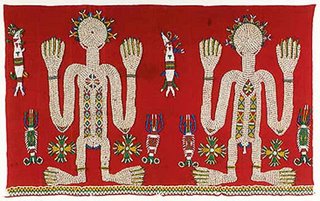Fashion and Art at the Indianapolis Museum of Art
Fashion and Art at the Indianapolis Museum of Art : jun, 20, 2006, artdaily.com

Indonesia, Sumba. woman's ceremonial skirt, about 1900. imported cotton fabric, nassa shells, trade glass beads. Eliza M. and Sara L. Niblack Collection.
INDIANAPOLIS.- The Indianapolis Museum of Art presents the exhibit I Do: The Marriage of Fashion and Art through February 25, 2007. Wedding gowns, veils and other bridal attire and furnishings have been a traditional part of marriage rites in world cultures for hundreds of years. I Do, an exhibition opening June 11 in IMA's new galleries for textile and fashion arts, celebrates these important traditions. Fifteen Western wedding gowns—12 American and three European—will be displayed in the Paul Fashion Arts Gallery, and 30 wedding garments and other nuptial pieces from Asia and Africa will be shown in the Paul Textile Arts Gallery.
The Western gowns range from a silk damask dress made in Boston in 1837 to a Christian Lacroix "Wedding Cake" dress created in the late 1980s. The sumptuous materials used in the gowns include silk satin and silk chiffon, velvet, lace, crepe and taffeta. While some of these dresses were too ornate to be worn for other occasions, many had a life after the wedding, at evening receptions and formal parties.
Bridal attire from Asia and Africa—all made between the late 19th and mid-20th century—includes ensembles from China, a colorful Indonesian wrapper embroidered with shells and beads, several ensembles from India, a kaftan from Morocco, and a bridal skirt and train made by the Ndebele people of southern Africa. Photomurals in this part of the exhibition show how the garments were worn. With their exquisite workmanship, rare and precious materials and rich ornamentation, these wedding garments underscore the importance of the marriage rite in the lives of people everywhere.
The Dorothy and Lee Alig Textile Learning Center—located next to the galleries—will showcase different fabrics and yarns and ways in which they are dyed and treated. Twelve small mannequins display the changes in the silhouettes of dress shapes from the 1770s to the 1960s. This space will allow visitors of all ages the opportunity to touch and to feel the textures of the different fabrics and materials. The Textile Learning Center also includes photomurals and a short video featuring marriage ceremonies from several cultures throughout the world.

0 Comments:
Post a Comment
<< Home